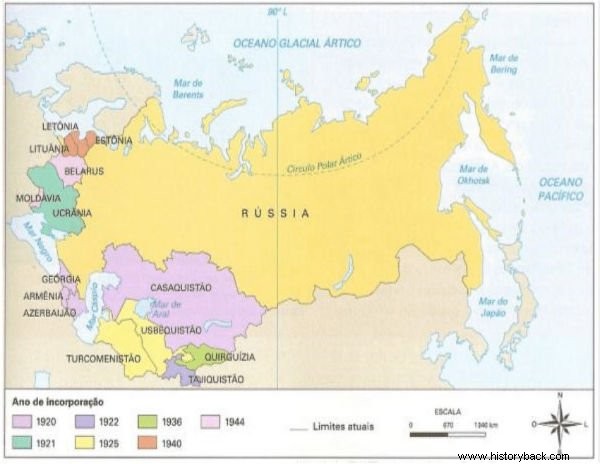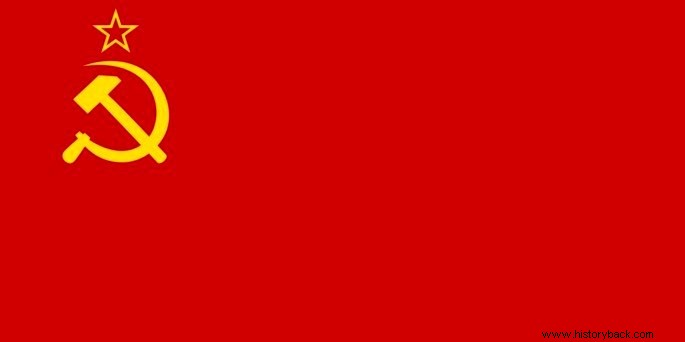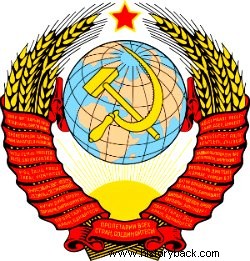The USSR , acronym meaning Union of Soviet Socialist Republics, was created on December 30, 1922 and dissolved on December 26, 1991.
The Soviet Union consisted of 15 republics that occupied half of Eastern Europe and a third of Northern Asia.
In the period in which it existed as a sovereign federal state, it was the second largest country in the world and the second world power.

History of the Soviet Union
The roots of the USSR are in the Revolution of 1917 and the Russian Civil War (1918 and 1921). Officially, the Union of Soviet Socialist Republics was created on December 30, 1922, at the end of the Congress of Soviets. These were a council that brought together workers, soldiers and peasants.

In the beginning, the union was made up of Russia, Ukraine, Belarus and Transcaucasia (Armenia, Azerbaijan and Georgia). The four republics emerged as a result of the collapse of the Russian Empire and the October Revolution of 1917.
Between 1922 and 1991, the USSR had 15 Soviet republics:
- Russia
- Ukraine
- Belarus
- Uzbekistan
- Kazakhstan
- Georgia
- Azerbaijan
- Lithuania
- Moldova
- Latvia
- Kyrgyzstan
- Tajikistan
- Armenia
- Turkmenistan
- Estonia
The 15 republics represented the union of at least one hundred ethnic groups from Asia and Europe who had the right to self-determination as peoples.
The union contributed to the concentration of reconstruction efforts after World War I (1914-1918). The civil war also reduced Russian industrial production by 18% and agriculture by 30%.
As a result of the conflict, nine million people died, including civilians and soldiers. The end of the war was also marked by the replacement of the economic concept imposed by Lenin in 1917.

USSR coat of arms
Economy in the Soviet Union
The NEP (New Economic Policy) was characterized by the coexistence of capitalist and socialist practices. It lasted until 1928, four years after Lenin's death, and with Stalin's victory over Trotsky. From that point onwards, the regime becomes of a unique socialist character, under the command of the Communist Party of the Soviet Union.
Stalin's economic policy was based on the adoption of the Five Year Plans, overseen by Gosplan. This was an economic planning commission responsible for planning the Soviet economy.
Under Stalin's command and Gosplan's supervision, the five-year plans provided for the encouragement of heavy industry and the collectivization of agriculture. Private ownership was replaced by state-owned cooperatives and farms.
Initially, the collectivization of land caused great disruption in rural areas, as peasants did not have the means to cultivate the land. Thousands of people starved to death as a result of this change in the ownership system.
In ten years, the five-year plans changed the economic and social profile of the Soviet Union. There was an increase in the production of energy, automobiles, weapons, oil and coal extraction.
Investments in the training of physicians, provision of hospital beds, libraries and schools also grew. Until the revolution, there were 640 books for each group of 10,000 inhabitants of the countries that would form the USSR. The offer increased to 8,610 books for each group of 10,000 inhabitants in 1939.
The USSR's economic and social evolution was considered fundamental to its performance in World War II, when 27 million people died.
At the same time, Stalin's opponents were eliminated or expelled. The USSR was isolated from the Crisis of 1929 and the Great Depression that followed in the 1930s.
World War II and the Cold War
However, the country did not leave the Second World War unscathed, losing 16.5 million people, both civilian and military.
Even having fought on the side of the Allies, the USSR and the US drifted apart due to their political and economic differences. Thus, two blocks were created in the world, when the so-called Cold War period begins.
Berlin Wall
Socialist ideology was a counterpoint to capitalism polarized by the United States on the western side. The symbol of the division of the world between capitalist and socialist poles was the Berlin Wall.
The wall was erected in August 1961 and torn down in November 1989.
USSR after Stalin
It is in this period that the political model begins to wither as a consequence of the centralization imposed by Stalin. The Soviet leader was known for the concentration of power and abuse of authority.
After his death, the successor Nikita Khrushchev chooses to reform the party and seek a timid opening with other countries.
Khrushchev would be responsible for revealing the political repression that took place during Stalin's government. In a speech before the party, he showed the arbitrary arrests and assassinations Stalin used to eliminate his opponents.
The period is marked by the collapse of the urban housing system, food production and consumer goods. The degradation of the socialist bloc is accentuated in the 1980s, when Mikhail Gorbachev takes power.
Perestroika and Glasnost
Among the hallmarks of Gorbachev's leadership are the Perestroika and Glasnot programs. Both had goals of political and economic opening of the country.
Under Gorbachev, the USSR reduced military spending, aid to socialist countries and political interference in these nations.
End of the USSR
The 1990s in the USSR are marked by independence movements in several republics. The result was the dissolution of the USSR at the end of 1991, after the creation of the CIS (Commonwealth of Independent States).
When it was dissolved, the USSR concentrated 22 million square kilometers and a population of 288.6 million people.
Read Also :
- Russia
- Community of Independent States
- End of the USSR
